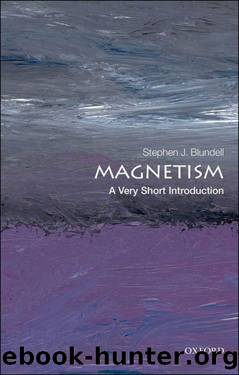Magnetism: A Very Short Introduction (Very Short Introductions) by Stephen J. Blundell

Author:Stephen J. Blundell [Blundell, Stephen J.]
Language: eng
Format: mobi
Publisher: Oxford University Press
Published: 2012-06-27T21:00:00+00:00
9. (a) A ferromagnet; (b) an antiferromagnet; (c) a domain wall
This way of thinking explains an important fact. In a material like iron, the magnetism persists up to very high temperatures, up to the Curie temperature, which is 770°C, showing that the interaction is very strong. This strength can be traced back to the large energy associated with electrostatic repulsion.
If all this is true, why isnât every piece of iron you come across magnetic? The answer to this question is that every piece of iron is magnetic, but the magnetic structure often breaks up into small regions called domains. In each domain, the magnetism in every atom is aligned in the same way (we will again refer to atomic magnets as spins). Thus a domain contains spins that are aligned and point in the same direction, but different domains have all the spins within them that aligned differently. This means that, from the outside, the piece of iron does not appear to be magnetic because the effect of all the individual domains cancel out.
Why do they do that? This behaviour comes from an attempt to minimize energy. If a piece of iron exists as one domain, then it will produce a magnetic field outside which fills the space around it. But this magnetic field costs energy. Therefore, it is favourable for the magnetic structure to break up into domains because this removes the outside stray field and hence saves energy. Now even doing that comes at a price, because in the region between the domains we have to have what is called a domain wall (see Figure 9(c)). In a domain wall, the spins twist round from the configuration in one domain to that in its neighbour. This twisting also costs energy. So whether you get a single domain or many domains depends on a subtle balance between energy costs.
In a permanent magnet, like a piece of lodestone, or the magnet inside a motor, dynamo, or at the back of a loudspeaker, it is easy for the magnet to be in a single domain state. In such magnets, the cost of a domain wall is considerable and so they do not tend to form easily. If they do form, they are usually stuck in one place and very difficult to move. Such magnets keep their magnetism (unless they are warmed up above their Curie temperature), and to reflect their stubborn and unperturbable nature they are called hard magnets.
However, a piece of pure iron is a soft magnet in which the cost of making a domain wall is very small. Such magnets easily break up into a multi-domain structure. They can be easily magnetized and just as easily demagnetized. This makes them very useful in applications in which the magnetization needs to be switched on and off. For example, in the core of a transformer, there is a piece of iron which is magnetized backwards and forwards 50 or 60 times a second (depending on whether your electricity runs at 50
Download
This site does not store any files on its server. We only index and link to content provided by other sites. Please contact the content providers to delete copyright contents if any and email us, we'll remove relevant links or contents immediately.
The Complete Stick Figure Physics Tutorials by Allen Sarah(6639)
Secrets of Antigravity Propulsion: Tesla, UFOs, and Classified Aerospace Technology by Ph.D. Paul A. Laviolette(3450)
Thing Explainer by Randall Munroe(3328)
The River of Consciousness by Oliver Sacks(2992)
The Order of Time by Carlo Rovelli(2714)
I Live in the Future & Here's How It Works by Nick Bilton(2525)
How To by Randall Munroe(2476)
A Brief History of Time by Stephen Hawking(2474)
The Great Unknown by Marcus du Sautoy(2186)
What If?: Serious Scientific Answers to Absurd Hypothetical Questions by Randall Munroe(2170)
Blockchain: Ultimate Step By Step Guide To Understanding Blockchain Technology, Bitcoin Creation, and the future of Money (Novice to Expert) by Keizer Söze(2138)
Midnight in Chernobyl by Adam Higginbotham(2079)
Networks: An Introduction by Newman Mark(1998)
The Meaning of it All by Richard Feynman(1909)
Easy Electronics by Charles Platt(1864)
The Tao of Physics by Fritjof Capra(1850)
When by Daniel H Pink(1777)
Midnight in Chernobyl: The Untold Story of the World's Greatest Nuclear Disaster by Adam Higginbotham(1775)
Introducing Relativity by Bruce Bassett(1755)
